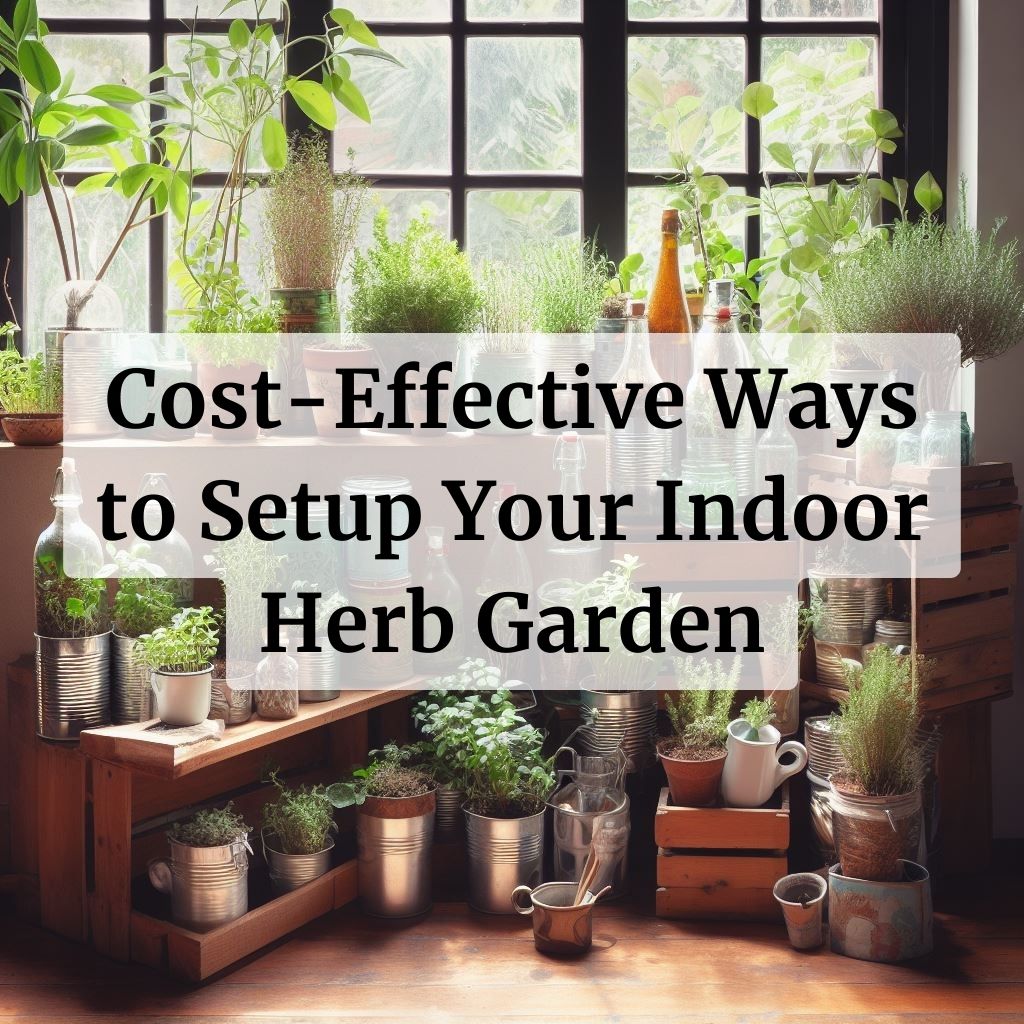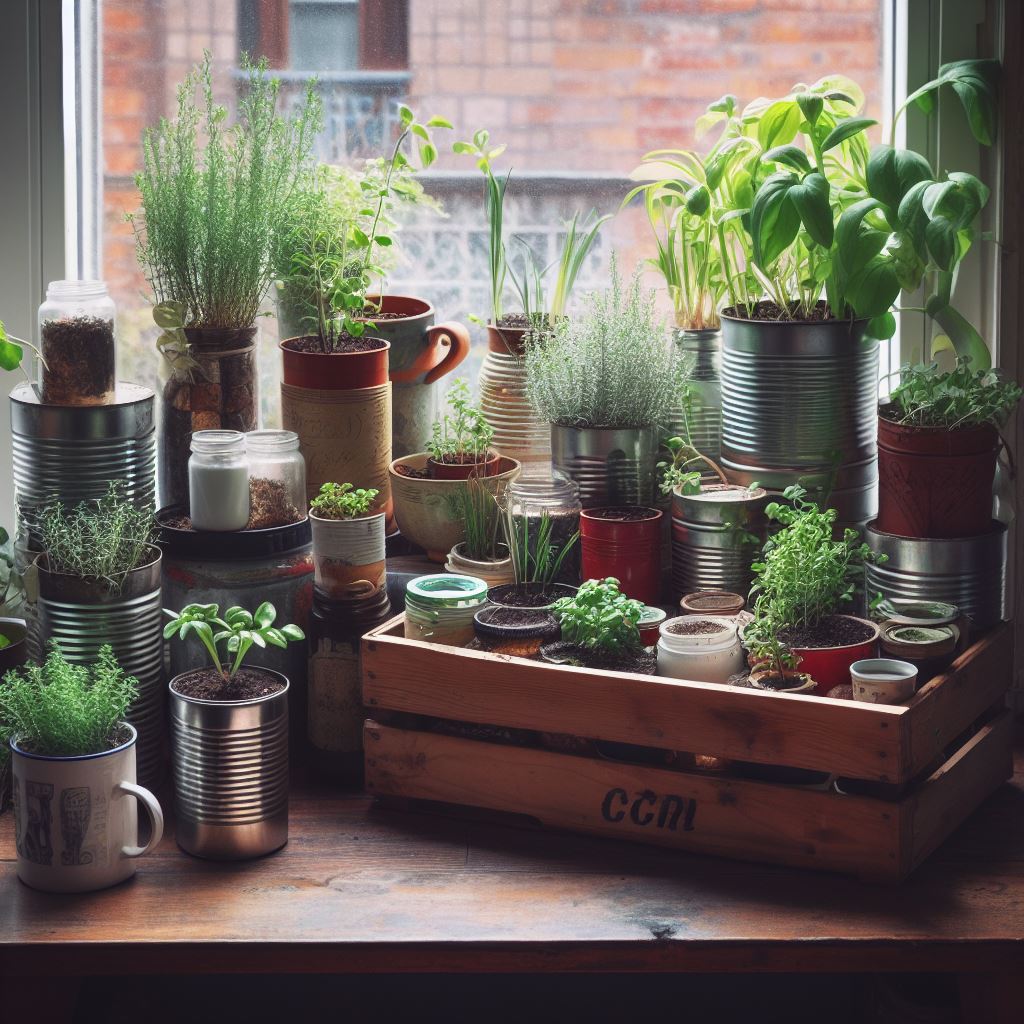
Gardening doesn’t have to be an expensive hobby. In fact, you can set up your indoor herb garden without breaking the bank. Here are 4 cost effective ways to create your herb garden.
In this article
Key takeaways
Here are some cost-effective ideas for setting up your indoor herb garden:
- Use recycled materials such as cans, bottles, jars, or boxes as planters. This way, you can save money and reduce waste at the same time.
- Make use of vertical space by hanging your herbs from the ceiling, wall, or window.
- Grow your herbs in water instead of soil. This is called hydroponics, and it can be done with simple materials such as glass jars, water, and nutrient solution.
- Start your herbs from seeds or cuttings instead of buying plants.
1. Using Recycled Materials
Some ideas for indoor herb gardens created with recycled materials are:
Using old tin cans as planters for your herbs. You can paint them, wrap them with fabric, or knit covers for them to make them more attractive. You can also punch holes in the bottom for drainage and hang them from hooks or wires.
You can use plastic bottles as hydroponic systems for your herbs. You can cut the bottles in half and use the top part as the planter and the bottom part as the reservoir. You can also add a wick or a tube to transfer the water and nutrients from the reservoir to the planter.

You can use wooden crates, boxes, or pallets as raised beds for your herbs. You can fill them with soil and compost and plant your herbs in rows or sections. You can also add wheels or handles to make them movable.
You can use egg cartons, muffin tins, or ice cube trays as seed starters for your herbs. You can fill them with soil and seeds and place them in a sunny spot. Once the seedlings sprout, you can transplant them to larger pots or containers.
You can use teacups, mugs, or jars as mini pots for your herbs. You can drill holes in the bottom for drainage and place them on a tray or a saucer. You can also decorate them with stickers, labels, or ribbons.
You can also decorate your recycled containers with paint, stickers, or labels to make them more attractive.
Remember, you will need to drill some holes at the bottom for drainage and fill them with potting soil and your choice of herb seeds or seedlings. You can then place them on a windowsill, a shelf, or hang them on the wall. This is a great way to reuse and repurpose items that you already have at home.
2. Vertical Gardens
Some ideas for indoor herb gardens that hang from the ceiling, wall, or window are:
You can create a custom potted hanging herb garden by using planks, threaded rod coupling, nuts, washers, and hooks. You can arrange the pots on the planks and hang them from the ceiling with chains.
You can use wine bottles as planters for your herbs. Cut the bottles in half and use the top part as the planter and the bottom part as the reservoir. You can also add a wick or a tube to transfer the water and nutrients from the reservoir to the planter. Hang the bottles from the ceiling or the wall with wires.

You can use mason jars as mini pots for your herbs. Drill holes in the bottom for drainage and place them on a tray or a saucer. You can decorate them with stickers, labels, or ribbons, then attach them to a wood board and hang it from the wall or the window.
You can use kokedama-inspired herb holders to create a hanging herb garden. Kokedama is the practice of suspending the root ball of a plant in a mud ball coated in moss. You can wrap your herbs in moss and hang them from the ceiling or the wall with ropes.
You can use wooden crates, boxes, or pallets as raised beds for your herbs. You can fill them with soil and compost and plant your herbs in rows or sections. You can also add wheels or handles to make them movable. You can hang them from the wall with brackets or hooks.
You can buy a vertical garden planter that allows you to grow up to 36 plants in a small space. This planter consists of five stackable tiers that can be rotated 360 degrees for optimal sunlight exposure. It also has a self-watering system that reduces the need for frequent watering. You can grow a variety of herbs such as basil, parsley, mint, oregano, and more in this planter. There is wide variety of vertical planters on Amazon.com to choose from, ranging from $25 and upwards.
You can use hooks, chains, ropes, or wires to create a hanging system. This will allow you to grow more herbs in a small area and also add some greenery to your home.
3. Hydroponic Gardening
You can invest in a hydroponic growing system that uses water and nutrients instead of soil to grow plants faster and healthier. Some of these systems come with LED grow lights that simulate natural sunlight and timers that control the lighting and watering cycles. You can also monitor and control some of these systems with your smartphone or tablet via an app. These systems can grow up to 12 plants at a time and are suitable for herbs, lettuce, tomatoes, strawberries, and more. They range from $40 to $200 on Amazon.com depending on the size, design, and features.
You can also use an old aquarium or fish tank as a hydroponic system. Hydroponics can help you save water, space, and avoid pests and diseases.
4. Growing Plants from Cuttings
Another budget-friendly option is starting your herbs from seeds or cuttings. This not only saves money but also gives you greater control over the quality and variety of your herbs. You can collect seeds from existing plants, buy them online or from a local nursery, or take cuttings from friends’ or neighbors’ herbs. This will also give you more control over the quality and variety of your herbs.
READ MORE: What is the best way to start an indoor herb garden, seeds or plants?
Beyond the practical benefits, seeing those tiny seeds grow ia a holistic experience that enriches your life in multiple ways.
From the financial relief of bypassing pricey supermarket herbs to the health benefits, convenience, environmental consciousness, and the sheer joy of nurturing life, the rewards are plentiful.
I hope these ideas help you create your own indoor herb garden that suits your budget and preferences.
Happy gardening! 😊







